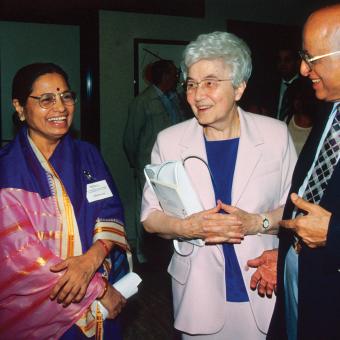During the horrors of World War II, Chiara Lubich lived with a group of young women companions in Trent, Italy. “While in the air-raid shelter, we came upon the page of the gospel which speaks of the testament of Jesus: ‘May they all be one, Father, as you and I are one,’ ” Lubich said of this time. “These words seemed to light up one by one. That ‘everyone’ expanded our horizon. That prayer for unity was to be the goal of our life.”
As Lubich and her companions began to discover a new spirituality of love and unity, they experienced that God is love. God called them to live a life of love so that he could be present in their midst, sharing with them and through them the gifts needed to build the spiritual and social unity for which Jesus had prayed.
Soon some 500 people joined them. They called their new movement Focolare or “hearth,” referring to the fire of God’s love and light that they experienced as the animating force in their lives in the darkness of wartime.
After the war, as the Focolare movement grew, it was approved by the Catholic Church, spread to Protestant denominations, and was embraced in the Orthodox Church. Later, close relationships of dialogue and friendship developed with Jews, Muslims, Hindus, and Buddhists as Focolare opened centers around the world.
At the time of Chiara Lubich’s death in 2008, more than 2 million people in 182 countries had been guided by her spirituality. Most are lay Catholics, but priests, religious, and bishops as well as people of other Christian denominations and of other religions, are also members of the Focolare movement.
I had the good fortune to meet Chiara Lubich in 1978 when I became a member of this movement. I was beginning my career in interreligious dialogue and knew that Lubich had won the Templeton Prize for Progress in Religion in 1977 in part due to her work in interfaith dialogue. I took the opportunity to ask her for some guidance, and she offered me three guidelines for my future work.
The first guideline emphasizes the foundational importance of what the church calls “the dialogue of life.” In dialogue one needs to open oneself first and foremost to a deep and, in Lubich’s words to me, “alive” relationship with persons of other faiths. For her, to be “alive” to others means to be “empty” of yourself. You must “live” the experience of the other, to “make yourself one” with the other person and his or her life.
Three years ago, I went to a meeting in Washington with Imam Mikal Saahir, an African American Muslim leader. The trip, rather than the meeting, taught me the most. I was able to “live” in a certain sense what Mikal lives each day as a black Muslim. Observing instances of discrimination at the airport and intolerance in a restaurant, taking time for prayer at the airport chapel, and talking about what our faiths mean to us laid the basis for deeper interfaith understanding, friendship, and collaboration.
Following the early church fathers, Chiara Lubich also said that God has sown “seeds” of truth in all religions, which have grown to provide spiritual, moral, and intellectual fruit that nourish the lives of millions of people around the world. Her second guideline was to search for these truths and be enriched by their fruit, while also sharing the riches of our own tradition.
In the 1980s and ’90s, I used this guideline in dialogue about self-emptying love and compassion with the famous Buddhist philosopher Masao Abe and others. Enriched by the Buddhist experience, the self-emptying love of Jesus (Phil. 2:5-8) became a fruitful focus for dialogue in the church as well as a powerful spiritual practice for me personally.
Lubich’s third guideline affirmed the importance of developing personal relationships with people of different faiths in order to build bridges of unity. I’m reminded of a story that Emily Soloff, director of the American Jewish Committee in Chicago, shared with me about a Catholic-Jewish Symposium of Focolare in Italy. When someone took out a camera to take a picture, her first instinct was to ask him not to, thinking it was the Sabbath even though it was not.
“The spirit of Shabbat so permeated the symposium that ordinary time melted into sacred time for me,” she said. “I felt an extraordinary sense of unity with everyone.”
When I participate in interreligious dialogue following the guidelines of Chiara Lubich, I feel that I am joining people such as Mikal, Masao, and Emily in contributing to a more united, just, and peaceful world—and that’s something that is sorely needed in this new century.
This article appeared in the April 2010 issue of U.S. Catholic (Vol. 75, No. 4, pages 47-48).













Add comment